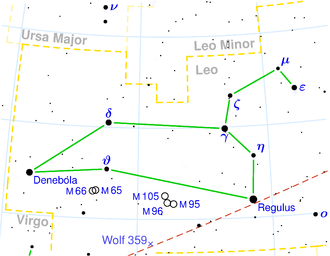NGC 3803
| Galaxy NGC 3803 |
|
|---|---|

|
|
| SDSS recording | |
| AladinLite | |
| Constellation | lion |
|
Position equinox : J2000.0 , epoch : J2000.0 |
|
| Right ascension | 11 h 40 m 17.2 s |
| declination | + 17 ° 48 ′ 04 ″ |
| Appearance | |
| Morphological type | E0 |
| Brightness (visual) | 15.5 mag |
| Brightness (B-band) | 16.5 mag |
| Angular expansion | 0.4 ′ × 0.4 ′ |
| Surface brightness | 13.6 mag / arcmin² |
| Physical data | |
| Redshift | 0.011938 +/- 0.000120 |
| Radial velocity | 3579 +/- 36 km / s |
|
Stroke distance v rad / H 0 |
(157 ± 11) · 10 6 ly (48.2 ± 3.4) Mpc |
| history | |
| discovery | RJ Mitchell |
| Discovery date | March 27, 1856 |
| Catalog names | |
| NGC 3803 • PGC 36204 • 2MASX J11401725 + 1748044 • GALEX ASC J114017.25 + 174805.2 • LEDA 36204 | |
NGC 3803 is an elliptical dwarf galaxy of the Hubble type E0 in the constellation Leo, north of the ecliptic . It is estimated to be 157 million light years away from the Milky Way and has a diameter of about 20,000 ly.
In the same area of the sky are the galaxies NGC 3790 , NGC 3801 , NGC 3802 , NGC 3806 .
The object was discovered by RJ Mitchell on March 27, 1856 .
